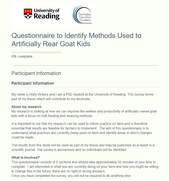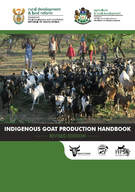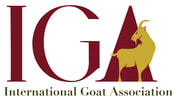|
PreCOP 26 Side Event “All4Climate-Italy 2021” – October 1, 2021 Pre-COP26 webinar showcases the Peste des petits ruminants Global Eradication Programme as an enabler of climate resilience
0 Comments
Small ruminants (goats and sheep) are kept for multiple purposes and provide a modest, but increasing, contribution to national production of red meat and milk. Most products are consumed by the household or traded through informal markets. Industry snapshot:
Small ruminant production systems Pastoralism with larger herds
Smallholder herds
Smallholder intensive
Report submitted by Intercooperation Social Development India Special thanks to Mamta Dhawan (IGA CR - India)  Executive Summary Introduction International Fund for Agricultural Development (IFAD) mandated Intercooperation Social Development to conduct goat value chain analysis. The objectives of the analysis are to:
Goat Production India with 135 million goat population ranks second in the world in goat meat production and its Gross Domestic Product (GDP) value is Rs. 386 billion. Economically weak and socially backward communities keep goat as subsistence. The goat production system in the country is categorized as Extensive Grazing (predominant in Odisha), Tethering (Parts of Bihar and Eastern UP), Semi-Intensive Production and Intensive Production Systems. Women perform major activities in goat keeping while men play key role in marketing. Primary source of goat nutrition is through extensive grazing/browsing with zero to marginal supplements at homes. In addition, some of the challenges in goat feeding include shortage of crop residue with change in pulse cropping and stringent forest regulations. High mortality, especially of kids (up to 40%) due to diseases like Peste des Pettis Ruminants (PPR), Foot and Mouth Disease (FMD) and poor management are major challenges in the goat sub-sector. Despite the Government of India (GoI) initiatives, the estimated annual loss on account of PPR was Rs. 1204 billion in small ruminants and Rs.23.19 billion due to FMD (large ruminants and small ruminants put together). Non-availability of quality breeding stock is another major challenge resulting in low productivity. The National Livestock Mission (NLM) programme of the Government of India promotes small ruminant development initiatives by using the platforms of women’s Self Help Groups (SHG) and also other cooperative structures. READ THE FULL REPORT  My name is Holly Vickery, and I am a PhD student at the University of Reading, United Kingdom. There is currently very little information on management systems for goats worldwide, and even less which focuses explicitly on the husbandry of kids that are reared artificially (away from their mothers). My research is looking at how we can improve the welfare and productivity of artificially reared goat kids with a focus on milk feeding and weaning methods. It is important to me that my research can be used to inform practice on-farm and is therefore essential that results are feasible for farmers to implement. This questionnaire aims to understand what practices are currently used on-farm and identify areas in which changes could be made. There is no geographical limit on this survey, so wherever you are – if you’re artificially rearing goat kids, you are able to participate! The survey should only take about 10 minutes of your time to complete. Please participate in my survey if you’re able to https://reading.onlinesurveys.ac.uk/questionnaire-to-identify-methods-used-to-artificially-rea Thank you, Holly Vickery [email protected]  Download a copy here. Download a copy here. The 3rd edition of the Indigenous Goat Production Handbook is available. This book aims to assist owners of indigenous goats with semi-intensive and extensive farming systems. It looks at ways to improve the productivity of their herds and start commercializing. This edition contains an expanded section on internal parasites, specifically worms, innovations that have been carried out with farmers in South Africa such as goat dips and kid enclosures, and the results of lessons learned since the last edition. The book is part of an ongoing collaboration of the KwaZulu Natal Goat Agribusiness Project with HPSA, Mdukatshani, and the South African government and vets. For more information on the project visit www.gapkzn.co.za. Or contact Marisia Geraci, [email protected]. Special thanks to Marisia Geraci, IGA Country Representative for South Africa.  Written by H.R. Bahmani, N. Papi, F. Mirzaei Animal Science Research Institute of Iran, Karaj, Iran History of goat breeding in the province The archaeological excavations show that Aryans were the first to domesticate goats for the first time. They were domesticated more than 9000 BC in Asia and the Middle East, especially in the lands now called Kurdistan. Given the many similarities in terms of coverage and characteristics of the produced fiber between Markhoz goats and Angora goats, they have been known as Iranian Angora goats and their fiber as mohair in some references. Some researchers assume the center of Anatolia and many have speculated Asia Minor as the origin place of Angora goats, especially where Kurds live in Iran, Iraq, and Turkey. The variation in the goats in Kurdish areas supports the latter speculation. Markhoz goat population may have been part of the core Angora goats isolated from its population in Iraq and Turkey for long years. Geographic distribution areas Markhoz goats have dispersed for years away in the provinces of Kurdistan, West Azerbaijan, and Kermanshah. At present, there are only few of them in a small part of Kurdistan and West Azerbaijan provinces. More than 90 percent of the population of Markhoz goats are scattered in its natural habitat, in the county of Armarda in the vicinity of the city of Baneh  Cattle, pigs, sheep and goats Introduction In 1998 the Swedish Veterinary Association decided to adopt a general policy for the use of antibiotics in animals. Since then specific policies for the use of antibiotics in dogs and cats have been adopted and in 2011 Guidelines for the use of Antibiotics in Production animals – Cattle and Pigs, were accepted. By decision of the board of the Swedish Veterinary Society (SVS) these guidelines have been updated. The over-arching goal of SVS is to achieve a low and controlled use of antibiotics in Swedish animal production so that the first-hand choices of treatment remain efficient and that the spread of antimicrobial resistance – among animals and herds as well as in the food chain – is kept at a minimum. Keeping antimicrobial resistance in animals low is important also for human health, since we are all part of the same ecosystem. The authors of these guidelines hope that they may be useful for veterinarians in clinical practice when deciding on treatments for common diseases and ailments caused by bacteria. Sometimes the decision may even be to refrain from use of antibiotics and chose other ways of improving herd health. To read more of the introduction, download a copy here. Diseases in goats Ylva Persson, DVM, PhD Introduction In Sweden only one antimicrobial is registered for use in goats – benzyl penicillin procaine (BPP) (Penovet®, Boehringer Ingelheim Vetmedica, FASS VET. Sweden 2015). All other drugs for therapy need to conform to the EU cascade principle. Since goats might react with strong pain to injections with tetracycline other antimicrobials should be preferred if BPP cannot be expected to be effective. Mastitis Mastitis is the most important production disease in goat milk herds. Good udder health is important for animal welfare as well as from food safety aspects. The most frequently isolated udder pathogens in dairy goats in Sweden are Staphylo coccus (S.) aureus and coagulase negative staphylococci (CNS). Subclinical mastitis is seen more often than clinical. Zimbabwe – Goat Farming as a Business: a farmer’s manual to successful goat production and marketing1/7/2019 Compiled by the Department of Agricultural Research and Extension, Matopos Research Station Represented by J.L.N. Sikosana & T.S. Senda For the Department of Livestock Production and Development Supported by: SNV–Netherlands Development Organization  Introduction There are more than 3.5 million goats in Zimbabwe, of which 98 percent are indigenous breeds and owned by the smallholder farmers. Most of them are kept in the drier agro-ecological zones in Natural Ecological Regions IV and V and in tse-tse infested areas. Natural Region IV has a low rainfall subject to periodic droughts and extended dry spells. Overall, the importance of goats increases as the rainfall decreases. Goats are hardy and easier animals to look after, which can survive under harsh environments.  To participate in this book, contact Prof. Sándor Kukovics, the Academic Editor at [email protected]. About the book There are several papers published about goats kept and bred around the world, but a breed inventory covering goat breeds on various continents (and countries) is missing. We propose to create this book. Goats (Capra) will be very useful for people interested in goats. Along with an inventory, there will be summarized information about why these goats were bred, their products, and what kinds of developments in targeting better meat, milk, hair, pelt, and skin production have been carried out until now.  download a copy download a copy Produced by: Mdukatshani, HPSA, Department of Rural Development and Land Reform (DRDLR) and KwaZulu-Natal Department of Agriculture and Rural Development (DARD) Special thanks to Marisia Geraci, IGA's Country Representative for South Africa for sharing this information. How to use this book The aim of this book is to assist owners of indigenous goats with extensive farming systems. It looks at ways to improve the productivity of their herds. It is designed to be shared with farmers in a way that allows them to understand how to find their way through the book and how to find the information that they need. It is best if the book is used as part of a capacity building programme being implemented by extension officers and field workers. There are further training materials to support training farmers with this book. They are available at www.mdukatshani.com, www.hpsa.org.za or www.gapkzn.co.za. These are training modules linked to sections in the book and can be downloaded as pdfs for printing, or as PowerPoint presentations. These training materials reference this book’s sections and pages. |
IGA Blog
The International Goat Association promotes goat research and development for the benefit of humankind, to alleviate poverty, to promote prosperity and to improve the quality of life. Archives
May 2024
Categories
All
|
|
International Goat Association
2516 Millbrook Rd., Little Rock, AR72227 USA email: [email protected] -454-1641 |



 RSS Feed
RSS Feed